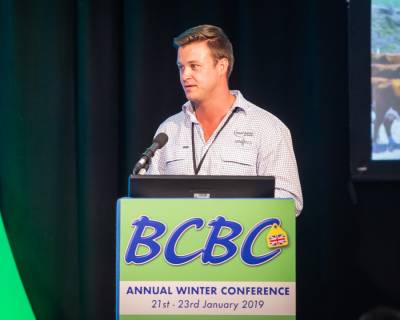
Abstract
An insight to a project in New Zealand, progeny testing 5 breeds of bulls across 2200 commercial cows a year head to head in country ranging from steep hills and low stocking rates to high input lowland country. How is this project using objective information to shape breeding decisions and breeders’ thinking? And how could information of this kind change an industry and the prominence of high-quality beef in a world where consumer is key and vegans are only a meal away?
Beef+Lamb New Zealand Genetics
Beef+Lamb New Zealand Genetics (B+LNZ Genetics) is an industry organisation that provides the information infrastructure to allow New Zealand’s sheep and beef industry to make profitable breeding choices. Established in 2014, it is a subsidiary of Beef+Lamb New Zealand and is funded by levies, the New Zealand government and thirdparty investment.
B+LNZ Genetics manages and develops the world leading genetic evaluation – Sheep Improvement Limited and its service tool nProve. In beef, the majority of genetic evaluation is breed society driven and provided by Breedplan in Australia. However, New Zealand beef genetics research is driven from within the country and data is provided to Breedplan for genetic evaluation where possible. B+LNZ Genetics beef research programme includes; the Beef Progeny Test, the Maternal Cow Project, the Next Generation Herds Project and the Trans-Tasman Beef Cow Profitability Programme – run in conjunction with its Australian research partners.
New Zealand Beef Breeding
Over the last two decades, New Zealand has experienced a dairy industry boom. The national dairy herd has grown from 3.4 million cattle in 1993 to 6.49 million in 2017 (Beef+Lamb, 2017). As a result, 69% of the national kill of adult cattle is now of dairy origin – comprised of cull cows, Friesian bulls, and dairybeef calves reared for finishing. This has meant a major shift in the use of land to its most profitable use. Beef production on better quality land has contracted to make way for dairy cattle, and on poorer quality land has contracted to make way for expansion of forest plantations (Tweedie et al. 2018).
New Zealand’s temperate climate has resulted in pastoral systems of beef production, whereby farmers apply management practices that attempt to match nutritional demands of animals to the pasture growth curve (White et al. 2009). This is partially achieved through mixed livestock systems, where different species and classes of livestock have different requirements throughout the year; and by careful timing of reproductive cycles to coincide with pasture growth (Tweedie et al 2018). In this, sheep are nearly always run with beef cattle – much of which are rotationally grazed in pasture only systems. The beef cow is considered the ‘pasture groomer’ for other livestock classes and is often fed the poorer quality pasture on the steeper parts of New Zealand farms.
B+LNZ Genetics Beef Progeny Test
The B+LNZ Genetics Beef Progeny Test (BPT) has now completed its 5th Cohort. It is one part of an extensive beef genetics research programme carried out by B+LNZ Genetics and its research partners on commercial New Zealand beef farms.
The BPT was established as a result of 4 questions:
- What is the right type of cow for New Zealand hill country?
- What genetics are required to maximise finishing performance and hit market specifications?
- How do we balance maternal with finishing traits?
- Do the EBVs for these traits work and do they need improving?
As a result of those questions the BPT was established based on the following objectives;
- Quantify the value of investment in better bulls
- Demonstrate the tools in the breeder’s toolbox
- Improve the tools currently available for New Zealand beef breeding
- Do so on genuine commercial farms
The project has now completed its 5th beef cohort of around 2,000 cows (not including a further 1500 terminal dairy cow matings) representing 5 large commercial stations across New Zealand over a very broad range of land types. Some 50 Angus, Hereford, Simmental, Charolais and Stabilizer sires are progeny tested annually. Some sires have been as old as 12 years (with high accuracy EBVs and many calves) and as young as yearlings (low accuracy sires). Cows are un-shepherded at calving and steer and terminal heifer calves are recorded for growth, structural soundness, docility, carcase quality (both ultrasound and abattoir assessed). Maternal heifer calves are also recorded for novel fertility traits as yearlings and for repeated reproductive outcomes, cow type and cow fate/longevity.
The project undoubtedly has a strong extension/adoption theme. The uptake of Estimated Breeding Values (EBVs) and other genetic tools has been mixed in New Zealand beef breeding to date. In sheep breeding, the uptake is advanced and many of the rams sold are first grouped on $ Index to be valued for sale. Given a vast majority of farms run both sheep and beef on the same land – this is an interesting difference. A strong focus on adoption, rather than the traditional model of a focus data harvesting for research (only) – is a defining and unique aspect of the BPT.
Extension learnings from the BPT
As this project has progressed there have been some interesting extension observations that have been distilled into messages for potential application in the UK.
Bake your bread before you butter it
In other words – repeat the basics and reinforce them as much as possible before getting into the detail. Often in research – and as science based professionals, we are most excited and driven by the next and newest piece of information. This is often not the case for those farmers who don’t have a keen interest in genetics specifically – but of course have to purchase sires every year.
They need to hear the basics repeated – reinforcing that EBVs actually work (and are useful) before going the next step and selecting sires using them. This following case study is a breakdown of how we ‘baked the bread’ by validating Breedplan growth EBVs in 5 breeds of cattle.
Expectation: 200 Day Weight EBV
In the calf, roughly half the genes come from the cow and half come from the bull. That means we would expect half the benefit of a sires EBV to be passed on to the calf. In the theoretical example, Table 1 it is expected sires with heavier 200 Day Weight EBVs will wean heavier calves e.g. for every extra 1kg of sire 200 Day Weight EBV you expect to get an extra 500 grams of actual calf weaning weight on farm. This can also be seen in Figure 1 with an expected slope of 0.5, where the bulls from Table 1 are plotted on Figure 1.
Table 1: Theoretical bull EBVs matched to calf outcomes.
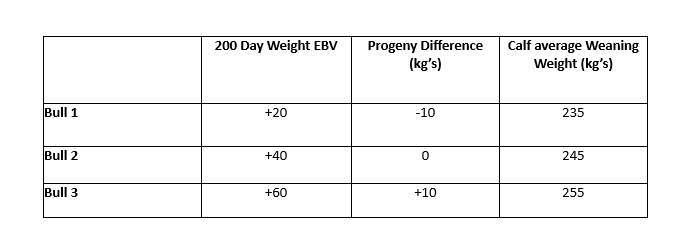
Figure 1: Theoretical bull EBVs matched to calf outcomes.
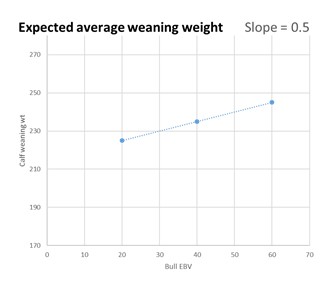
Reality
It was found that for every 1kg more in 200 Day Weight EBV, 490 grams was gained in average weaning weight on farm. Effectively 99% of the expected weaning weight advantage predicted by EBVs is being realised on NZ commercial farms. To reiterate, this was achieved across the country with 2200 cows, on five large scale commercial farms, five breeds and with high and low accuracy sires (see Table 2).
Table 2: Sire 200 Day Weight EBVs do an excellent job of predicting calf performance.
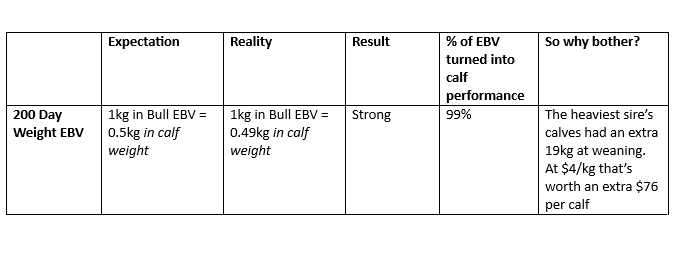
Although a fairly crude way to assess the performance of sires EBVs in predicting the performance of their calves
– percentage of EBV that turned into calf performance can be compared across all Breedplan traits that the BPT assessed.
– 90% of sires EBV turned into actual calf growth.
– Across 18 Breedplan traits assessed – 73% of sires EBVs turned into calf performance (see Figure 2).
Figure 2: Sire 200 Day Weight EBVs do an excellent job of predicting calf performance.
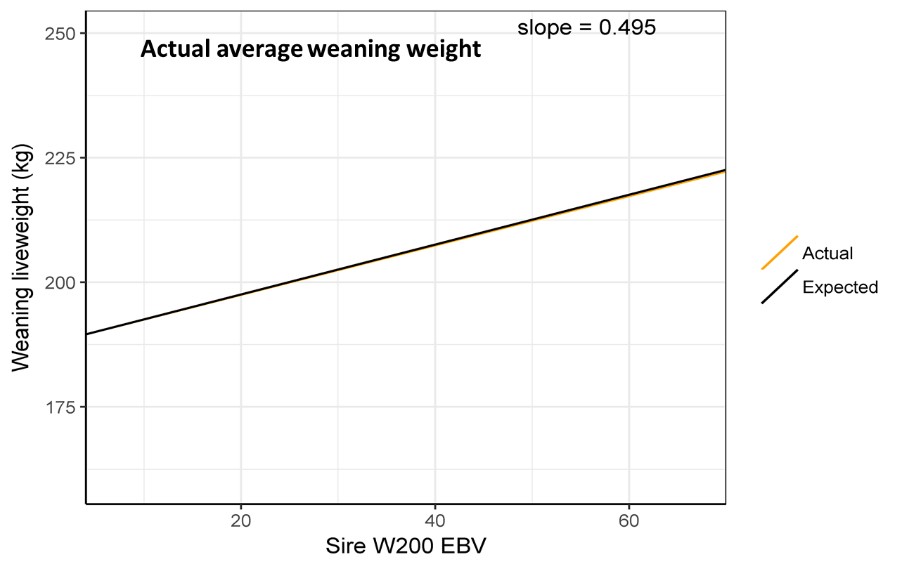
Farmers learn from farmers
In a general sense, the farming population in New Zealand is heuristic. This means that they learn from experience and from the experience of others. They are typically practical and like to see things done in a way that they can apply in their own businesses. In New Zealand the ‘Farmer of The Year’ farm tour field days are always hugely attended – in contrast to many of our extension days. This is put down to their love of ‘seeing how others do it’.
The BPT has built a champions network of leading farmers through the BPT. The BPT sites are leading farms in their areas. For example, Rangitaiki Station on the Central Plateau regularly achieves 70% + in calf rate to one round of Fixed Time Artificial Insemination (FTAI) despite having over 1400 cows and 10,000 ewes in an extensive environment of 8300 ha. The properties were selected because they are widely regarded as sources of information for other farmers due to their success and scale.
As a result, we now use the farmers and their staff in our messaging. They present genetics content at our field days and are the frontmen for our advertisements promoting the use of genetic tools. The BPT has shown us that farmers like to hear it from farmers and the BPT site managers are the projects biggest advocates.
In 2018 B+LNZ Genetics hosted a Virtual Beef Breeders Conference. This was an online forum with live, interactive videos and on demand sessions that were pre recorded. The videos featuring breeders were by far the most viewed. This lesson reinforced our findings. Breeders.
You have the mandate to measure
A difficulty in the industry is encouraging breeders to be objective. Putting the power in their hands to be the ones collecting high quality, complete data is a challenge for genetic evaluations around the world. For breeders to then use that data for selection – resulting in genetic gain, is the ultimate. Without subsiding or incentivising breeders to collect data – how do you encourage it?
Make it competitive
The BPT allows for excellent benchmarking for commercial farmers. As most of the average site metrics i.e. farm cow herd performance, growth rates, kill results etc. have been available to farmers to benchmark their own businesses against.
All BPT kills are off grass and cattle are grown and finished on the farms they were born on. Groups for slaughter are created at 12 months of age and cattle are run in those groups with all cattle from the given group being slaughtered on the same day. Figure 3 below shows the improvement (within the first season) between kills for farm slaughter performance. Each farm improved the percentage of cattle hitting the Beef Eating Quality index at successive kills. Results were shared between the farms. This made things competitive and encouraged the swapping of information on how to improve the respective sites results. A similar result was achieved by being totally transparent and sharing the sites FTAI results between the farms.
Figure 3: Year 1 BPT kill performance lifted which successive kills.
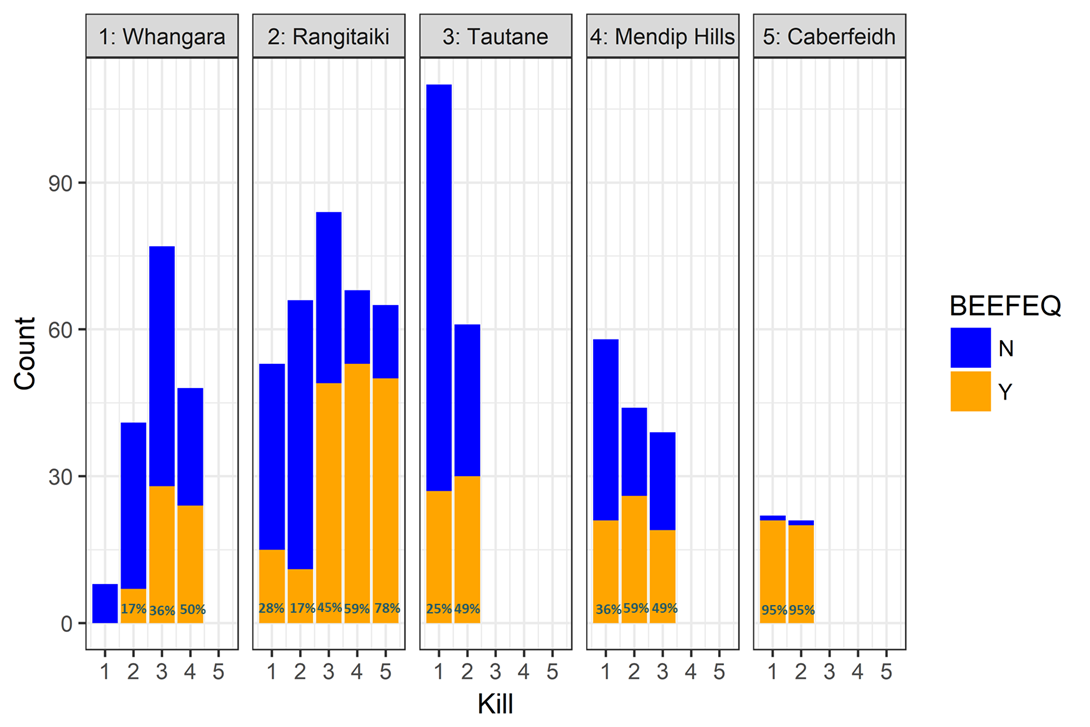
Putting in dollar terms
Farmers in New Zealand are motivated by economic opportunity. When all subsidies for agriculture were removed overnight in the 1980s – attitudes to farm profitability changed. As a result, when there is extra value obtainable from the use of technology – it is often taken advantage of. It is often said ‘money talks’ (see Table 3).
Table 3: Sires with improved EBVs had calves of increased value.

Your story to tell?
The world is changing. We are no longer as connected to our urban cousins as we once were. Their understanding of our challenges and empathy for our rationale for doing things has appeared to have declined. Their own motivations are changing and we inevitably have to meet them if we wish to have a future breeding and growing cattle for markets.
The 2018 publication of the 2018 EAT-Lancet Commission report recommended developed countries cut their red meat consumption by 80% to ‘protect the earth’. This report is both damming of red meat and misleading. It perpetuates the idea that industrial farming and grain diets for finishing animals is standard practice and the norm globally (EAT, 2018).
January is infact ‘Veganuary’. According to the Vegan Society – the highest number of vegans per capita are found (in order) Australia, UK and New Zealand. By their estimates – 1.16% of all people in the UK are now vegan – a number that has doubled year on year since 2015. Arguably these people aren’t going to be convinced easily to eat red meat again and their minds are probably set on the issue. However, they represent the extreme end of a growing group of society that is unhappy with red meat and its perceived impact on society (Vegan Society, 2018).
Beef in places like the UK and in NZ could infact consider this an opportunity. If our product is to be differentiated to meet the needs of this modern and ever discerning consumer, then there needs to be some serious consideration given to the positioning of it. Grass fed, sustainable systems are likely a part of the answer to this.
Rebuilding the trust
In New Zealand we have the famous Whittaker’s Peanut Slab. In 2018, the makers of this fine chocolate bar were named New Zealand’s most trusted brand for the 7th year in a row. They have generated an enormous amount of good will with NZ consumers over time by giving the people exactly what they want.
Based on the things that concern the modern consumer – could the UK Red Tractor Brand be built to gain the same trust Whittakers has in NZ but with UK red meat consumers? This brand could stand for trust and for the leading standards of meeting their demands/concerns. Progeny tests are excellent vehicles to produce meaningful statistics and information to fuel the debate on the trust red meats has with the consumer. Progeny tests are more than just research data sources or adoptions projects for farmers – they can be arms to the debate with those with genuine concerns about red meat.
Sustainability, welfare and eating quality appear to be recurring issues with the modern consumer and those dissatisfied with the state of red meat. An example of Progeny test derived metrics used in New Zealand is that in 20 years NZ sheep + beef farmers have reduced Greenhouse Gas emissions (GHG) from livestock by 30% (Beef+Lamb, 2018). Reinforced by a powerful article – ‘New Zealand scientists breeding sheep to fart and burp less’ – which sheds light on the development of genomic reference populations for selecting sheep for reduced GHG (ABC, 2018).
In a similar vein, traits like Body Condition Score and Parasite Resilience are meeting the consumers wish for high animal welfare and Intra Muscular Fat for eating quality – all traits that were developed from New Zealand sheep Progeny testing.
Conclusion
With good design – Progeny Tests can be so much more than just research data sources. Traditional models have been about generating data for research with little adoption or consumer end point advantages in mind. An industry project such as the BPT has had impacts on NZ farmers and (hopefully in time) consumers – could it have the same effect in the UK?
Acknowledgements
• AbacusBio Ltd
• Beef Progeny Test herds
• Simmental NZ
• Focus Genetics
References
ABC (2018) New Zealand scientists are breeding sheep to fart and burp less. ABC, Australia. URL https://www.abc.net.au/ news/rural/2018-06-07/new-zealand scientists-breed-sheep-that-fartand-burp-less/9841546
Beef+Lamb (2017) Mid- season update 2017-18. Beef + Lamb New Zealand, Wellington, New Zealand. Paper No. P17018. Beef + Lamb New Zealand 2017.
Beef+Lamb (2018) BLNZ welcomes launch of one billion trees fund. Beef+Lamb New Zealand, Wellington, New Zealand. URL https://beeflambnz.com/news views/blnz- welcomeslaunch-one-billion-treesfund?_cldee=bWF4LnR3ZWVkaWVAYmxuemdlbmV0aWNzLmNvbQ%3D%3D&recipientid=contact 80ac29f00300e411bed100155d320899-221e85caab464d3998fba7ecf29c7b84&esid=7bf7a7f2-fdf8-e811-a845-000d3ae0b82e&fbclid=IwAR307dDWOmX5kVm9xGvL-yW7BQ2gbnlQ6S8yqmFGrQm8Q7O8dN2JDHbGQys
EAT (2018) Lancet Commission Summary Report. EAT Lancet Commission Report on Food, Planet, Health. URL https://eatforum.org/content/uploads/2019/01/EAT-Lancet_Commission_Summary_Report.pdf
Tweedie, M., Morris, S.T., Hickson, R.E. (2018) The New Zealand Beef Industry. 11th World Congress on Genetics Applied to Livestock Production, proceedings 2018.
Vegan Society (2018) Vegan Statistics. Vegan Society, United Kingdom. URL https://www.vegansociety.com/news/media/statistics
White, T. A., Snow, V. O. & King, W. M. (2010) Intensification of New Zealand beef farming systems. Agricultural systems, 103(1), 21–35.